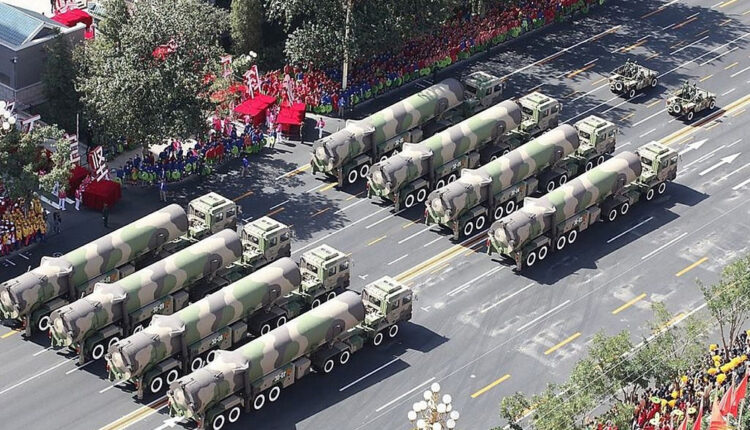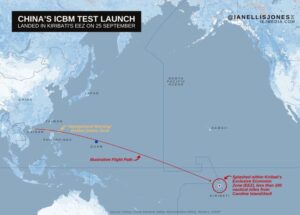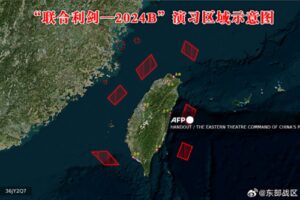China strengthens deterrence; successfully test fires ICBM
US reduced to words of protest over latest Taiwan drill

CHINA continues to strengthen its deterrent capability against US Imperialism and its minions, especially in the Asia-Pacific region, after the successful test fire of its DF31B intercontinental ballistic missile (ICBM) last September 25.
Sending the clear message that it is not intimidated over continuing efforts by the United States to surround its territory with military bases located in proxy countries like Japan, South Korea and the Philippines, China said the successful test fire using a dummy warhead landed in waters near Hawaii, the main US naval base in the Pacific Ocean.
Incidentally, the testing of the DF31B capability came on the same day that Philippine Foreign Affairs secretary, Enrique Manalo, spoke at the high-level dialogue of the 79th United Nations General Assembly (UNGA) where he again launched into another anti-China tirade over the latter’s alleged “aggression” in the South China Sea, but without directly naming China as a diplomatic requirement.
The Philippines’ position is in contrast with those taken by other countries at the 79th UNGA focused on directly condemning Israel and the United States over the continuing genocide and daily massacre of the Palestinians in Gaza, the West Bank and Lebanon, going on for more than one year now.
Based on available information in the Internet, the DF31 (‘DongFeng’ or ‘East Wind’) is a third-generation ballistic missile from the ‘DF Family’ first develop by China in 1985.
It is powered by a 3-stage solid fuel rocket that can carry a total load of one megaton ‘thermonuclear’ (hydrogen) warhead and a range reaching 13,200 kilometers—enough to hit targets anywhere in Asia, Europe, Canada, and the northwestern part of the United States that includes Seattle and Washington. This flight path is more than twice the defined 5,500 kilometers range of an ICBM.
The last time China tested a DF ICBM was more than 40 years ago, in May 1980, when it test-fired a DF5 that landed in the South Pacific.

China’s ICBM test in the Pacific Ocean,
September 25, 2024.
China watchers stressed the significance of the latest test, noting that “usually,” China tests its nuclear weapons in the remote areas of Xinjiang or the Bohai Sea, according to a report filed by the Associated Press a day after the test fire (‘What’s behind China’s launch of an intercontinental ballistic missile’).
Although a statement from China’s Ministry of Defense declared the launch was part of “routine training” by the Rocket Forces of the People’s Liberation Army (PLA), experts quoted in the AP article said China’s choice of the Pacific Ocean is both a “display of its increased nuclear capabilities and as a warning to the United States and its allies in the region.”
“There is no other potential audience, as China does not expect to have to confront the EU or the U.K. militarily,” said Steve Tsang, director of the SOAS China Institute in London, the AP report stated.
It also quoted Drew Thompson, a former defense official under the Obama administration overseeing Taiwan, China and Mongolia that the timing of the test– during the 79TH UNGA– “is a pretty blunt signal” to the international order.
“China is signaling that its forbearance has limits, that it is prepared to use its most powerful weapons to deter adversaries or punish them if needed, if deterrence fails,” Thompson was quoted as saying.
China’s decision to test fire the missile that subsequently flew over the airspace near the Philippines and Guam over a distance of 12,000 kilometers before landing in the waters near Hawaii and French Polynesia, also came after the Philippines reneged on its decision to send back the US ‘Typhoon’ missile system brought here in April for the regular US-Philippines joint ‘Balikatan’ military exercises.
The Russian Federation warned that the Typhoon system in the Philippines would be among those they would target in case of a war with the United States (see column of July 1, 2024).
The same warning was aired by China considering that Typhoon missiles can hit the Chinese mainland, especially its coastal cities facing the Philippines and Taiwan. Ironically, Pres. Marcos Jr. allowed the Typhoon to be placed in his own province of Ilocos Norte and in Cagayan province.
China’s military drills over Taiwan
In another round showcasing its military preparedness, China last October 14 conducted another huge military exercise covering nearly its entire province of Taiwan.
The latest exercise, called ‘Joint Sword-2024B,’ was held around the north, south and east of Taiwan and are meant to test the joint operations capability of the Chinese army, navy, air force and rocket force, the Chinese National Defense Ministry said in a statement, as quoted in a report by NBC News on the same day.
“The drill also serves as a stern warning to the separatist acts of ‘Taiwan Independence’ forces,” said Senior Capt. Li Xi, spokesperson for the People’s Liberation Army’s Eastern Theater Command. “It is a legitimate and necessary operation for safeguarding state sovereignty and national unity.”

The drill was in reaction to the speech of Taiwan’s purported “president,” Lai’s Tsing-te last October 10, Taiwan’s purported ‘Independence Day.’ Lai claimed that Taiwan and China “are not subordinate to each other” and that China has no right to represent Taiwan.
Last May 23, the PLA launched ‘Joint Sword 2024A’ to also test its military readiness after Lai’s election as president on May 20.
Lai always considered Taiwan an “independent” country and not a pseudo state existing only because of the backing of the United States.
During the presidential campaign, Lai claimed there is “no need” to formally declare Taiwan’s independence “because Taiwan is already a sovereign and independent country.”
Philippine president Ferdinand Marcos Jr. contributed to the tension after he issued a statement congratulating Lai.
Both exercises are China’s biggest around Taiwan since August 4, 2022, after Taiwan and the United States ignored China’s warning of the repercussion of the ‘official visit’ to Taiwan of then US House Speaker Nancy Pelosi on August 2.
Unlike its ICBM test where China notified the US, France, and New Zealand ahead of time, the military drill around Taiwan caught the US by surprise with Taiwan’s defense minister, Wellington Ko and Lai admitting they only learned of the military exercise “just hours” before it started.
US reduced to pathetic protests
Faced with the enormity of the forces that China deployed around Taiwan, the US was again reduced to issuing another pathetic statement of “concern” while attaching its default statement of being “committed” to its “longstanding one China policy.”
At the conclusion of China’s military drill in May, Mathew Miller, State Department spokesman, said the United States is “deeply concerned” over the People’s Liberation Army joint military drills in the Taiwan Strait and around Taiwan.
“We are monitoring PRC activities closely and coordinating with allies and partners regarding our shared concerns,” Miller stated on May 25. “We strongly urge Beijing to act with restraint. Using a normal, routine, and democratic transition as an excuse for military provocations risks escalation,” Miller stated, referring to Lai’s election.

After the latest Chinese military drill, Miller last October 13 almost paraphrase his May 25 press statement, saying:
“The United States is seriously concerned by the People’s Liberation Army joint military drills in the Taiwan Strait and around Taiwan. The PRC response with military provocations to a routine annual speech is unwarranted and risks escalation.
“We call on the PRC to act with restraint and to avoid any further actions that may undermine peace and stability across the Taiwan Strait and in the broader region, which is essential to regional peace and prosperity and a matter of international concern.”
In both instances, Miller has the US’ default statement regarding China, claiming, “The United States remains committed to its longstanding one China policy, guided by the Taiwan Relations Act, the Three Joint Communiqués, and the Six Assurances.”
Noticeably, absent from Miller’s statement is the US’ readiness to defend Taiwan in case of an invasion by China as it claimed it would do from its previous statements.
False claim on ‘One China Policy’
Such claim of adhering to its One China Policy is false over the way the United States has been propping up Taiwan since 1949 when its puppet army under the Koumintang was defeated by the Communists under Mao Zedong.
Only last September 29, Pres. Biden announced the approval of $567 million in fresh military assistance to Taiwan, upped from the $345 million in military aid it gave to Taiwan last year.
An article from the ‘Council of Foreign Relations’ last September 25, 2024 disclosed that since 1950, the United States had sold over $50 billion in military hardware and services to Taiwan.
The same article noted that Taiwan is expecting delivery of military weapons from the United States worth $20 billion, from a deal that was struck in 2019.
The outpouring of US military support to Taiwan is despite its agreement with China under the 1982 ‘Third Communique’ between Pres. Ronald Reagan and Chinese Premier Zhao Ziyang. Under the agreement, the US explicitly recognized that “there is one China and Taiwan is part of China.”
The communique also obliged the United States to “reduce gradually its arms sales to Taiwan.”
For its part, China commits itself of seeking a “peaceful solution” to its reunification with Taiwan.
The communique also affirmed both sides’ commitment to “respect for each other’s sovereignty and territorial integrity and non-interference in each other’s internal affairs,” as a “fundamental principle” in their relationship.
However, the demonstrated support by the United States to Taiwan, diplomatically, politically, militarily, and economically even after the normalization of their relationship confirmed the US’ lack of sincerity in its dealings with China.



Comments are closed.